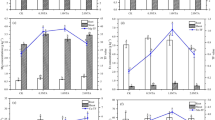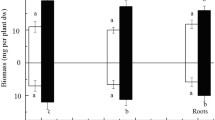Abstract
The low bioavailability of Pb and low number of Pb-tolerant plant species represent an important limitation for Pb phytoextraction. It was recently suggested that halophyte plant species may be a promising material for this purpose, especially in polluted salt areas while Pb mobility may be improved by synthetic chelating agents. This study aims to evaluate Pb extraction by the halophyte Sesuvium portulacastrum in relation to the impact of EDTA application. Seedling were cultivated during 60 days on Pb artificially contaminated soil (200, 400, and 800 ppm Pb) in the presence or in the absence of EDTA (3 g kg−1 soil). Results showed that upon to 400 ppm, Pb had no impact on plant growth. However, exogenous Pb induce a decrease in shoot K+ while it increased shoot Mg2+ and had no impact on shoot Ca2+ concentrations. Lead concentration in the shoots increased with increasing external Pb doses reaching 1,390 ppm in the presence of 800 ppm lead in soil. EDTA addition had no effect on plant growth but strongly increased Pb accumulation in the shoot which increased from 1,390 ppm in the absence of EDTA to 3,772 ppm in EDTA-amended plants exposed to 800 ppm exogenous Pb. Both Pb absorption and translocation from roots to shoots were significantly enhanced by EDTA application, leading to an increase in the total amounts of extracted Pb per plant. These data suggest that S. portulacastrum is very promising species for decontamination of Pb2+-contaminated soil and that its phytoextraction potential was significantly enhanced by addition of EDTA to the polluted soil.







Similar content being viewed by others
References
Abou Auda M, Abu Zinada I, El Shakh AE (2011) Accumulation of heavy metals in crop plants from Gaza Strip, Palestine and study of the physiological parameters of spinach plants. J Ass Arab Uni Bas App Sci 10:21–27
Aldrich MV, Gardea-Torresdey JL, Peralta-Videa JR, Parsons JG (2003) Uptake and reduction of Cr(VI) to Cr(III) by mesquite (Prospis spp.): chromate-plant interaction in hydroponics and solid media studied using XAS. Environ Sci Technol 37:1859–1864
Andra SS, Datta R, Sarkar D, Saminathan SKM, Mullens CP, Bach SBH (2009) Analysis of phytochelatin complexes in the lead tolerant vetiver grass [Vetiveria zizanioides (L.)] using liquid chromatography and mass spectrometry. Environ Pollut 157:2173–2183
Antosiewicz DM (2005) Study of calcium-dependent lead-tolerance on plants differing in their level of Ca-deficiency tolerance. Environ Pollut 134:23–34
Antosiewicz DM, Hennig J (2004) Overexpression of LCT1 in tobacco enhances the protective action of calcium against cadmium toxicity. Environ Pollut 129:237–245
Arnon DI, Hoagland DR (1940) Crop production in artificial solutions and in soils with special reference to factors affecting yields and absorption of inorganic nutrients. Soil Sci 50:463–484
Asp H, Gussarsson M, Adalsteinson S, Lenseń P (1994) Control of potassium influx in roots of birch (Betulapendula) seedlings exposed to cadmium. J Exp Bot 45:1823–1827
Baker AJM, Reeves RD, Hajar ASM (1994) Heavy metal accumulation and tolerance in British populations of the metallophyte Thlaspi caerulescens J. & C. Presl (Brassicaceae). New Phytol 127:61–68
Barrutia O, Garbisu C, Hernandez-Allica J, Garcia-Plazaola JI, Becerril JM (2010) Differences in EDTA-assisted metal phytoextraction between metallicolous and non-metallicolous accessions of Rumex acetosa L. Environ Pollut 158:1710–1715
Ben Rejeb K, Ghnaya T, Zaier H, Benzarti M, Baioui R, Ghabriche R, Wali M, Lutts S, Abdelly C (2013) Evaluation of the Cd2+ phytoextraction potential in the xerohalophyte Salsola kali L. and the impact of EDTA on this process. Ecol Eng 60:309–315
Brunet J, Repellin A, Varrault G, Terryn N, Zuily-Fodi Y (2008) Lead accumulation in the roots of grass pea (Lathyrus sativus L.): a novel plant for phytoremediation systems? CR Biogeosciences 331:859–864
Cecchi M, Dumat C, Alric A, Felix-Faure B, Pradere P, Guiresse M (2008) Multimetal contamination of a calcic cambisol by fallout from a lead-recycling plant. Geoderma 144:287–298
Chehregani A, Noori M, Yazdi HL (2009) Phytoremediation of heavy-metal-polluted soils: screening for new accumulator plants in Angouranmine (Iran) and evaluation of removability. Ecotoxicol Environ Safety 72:1349–1353
De la Rosa G, Jose RPV, Milka M, Jason GP, Irene CA, Jorge LGT (2004) Cadmium uptake and translocation in tumbleweed (Salsola kali), a potential Cd-hyperaccumulator desert plant species: ICP/OES and XAS studies. Chemosphere 55:1159–1168
Debez A, Huchzermeyer B, Abdelly C, Koyro HW (2010) Current challenges and future opportunities for a sustainable utilization of halophytes. In: M. Öztürk et al. (Eds.) Sabkha Ecosystems. Tasks for Vegetation Science pp: 59–77.
Egner H, Riehm H, Domingo WR (1960) Untersuchungen uber die chemische Bodenanalyse als Grundlage fur die Beurteilung des Nahrstoffzustandes der Boden, II. Chemische Extraktionsmethoden zur Phosphor-und Kalium bestimmung. Kungl Lantbrukshogsko Annal 26:45–46
Ehsan S, Prasher SO, Marshall W (2007) Simultaneous mobilization of heavy metals and polychlorinated biphenyl (PCB) compounds from soil with cyclodextrin and EDTA in admixture. Chemosphere 68:150–158
Ghaderian SM, Ghotbi Ravandi AA (2012) Accumulation of copper and other heavy metals by plants growing on Sarcheshmeh copper mining area, Iran. J Geochem Explor 123:25–32
Ghnaya T, Nouairi I, Slama I, Messedi D, Grignon C, Abdelly C, Ghorbel MH (2005) Cadmium effects on growth and mineral nutrition of two halophytes: Sesuvium portulacastrum and Mesembryanthemum crystallinum. J Plant Phys 162:1133–1140
Ghnaya T, Slama I, Messedi D, Grignon C, Abdelly C (2007) Cd-induced growth reduction in the halophyte Sesuvium portulacastrum is significantly improved by NaCl. J Plant Res 120:309–316
Hunt R (1990) Basic growth analysis. Plant growth analysis for beginners. UNWIN HYMA, London, p 112
Kalra YP, Maynard DG (1991) Methods for forest soil and plant analysis. Information report NOR-X-319. Northern Forestry Center, Forestry Canada, Northwest Region, p 116
Kibria MG, Islam M, Osman KT (2009) Effects of lead on growth and mineral nutrition of Amaranthus gangeticus L. and Amaranthus oleracea L. Soil & Environ 28:1–6
Komárek M, Tlustŏs P, Szákova J, Richner W, Brodbeck M, Sennhauser M (2007) The use of maize and poplar in chelant-enhanced phytoextraction of lead from contaminated agricultural soils. Chemosphere 67:640–651
Lai HY, Chen ZS (2005) The EDTA effect on phytoextraction of single and combined metals-contaminated soils using rainbow pink (Dianthus chinensis). Chemosphere 60:1062–1071
Lambrechts T, Gustot Q, Couder E, Houben D, Iserentant A, Lutts S (2011) Comparison of EDTA-enhanced phytoextraction and phytostabilisation strategies with Lolium perenne on a heavy metal contaminated soil. Chemosphere 85:1290–1298
Larbi A, Morales F, Abadía A, Gogorcena Y, Lucena JJ, Abadía J (2002) Effects of Cd and Pb in sugar beet plants grown in nutrient solution: induced Fe deficiency and growth inhibition. Funct Plant Biol 29:1453–1464
Lasat MM, Pence NS, Garvin DF, Ebbs SD, Kochian LV (2000) Molecular physiology of zinc transport in the Zn hyperaccumulator Thlaspi caerulescens. J Exp Bot 51:71–79
Liphadzi MS, Kirkham MB (2006) Availability and plant uptake of heavy metals in EDTA-assisted phytoremediation of soil and composted biosolids. S Afr J Bot 72:391–397
Liu D, Islam E, Li T, Yang X, Jin X, Mahmood Q (2008) Comparison of synthetic chelators and low molecular weight organic acids in enhancing phytoextraction of heavy metals by two ecotypes of Sedum alfredii Hance. J Hazard Mater 153:114–122
Min XB, XieX D, Chailly LY, Liang YJ, Li MI, Yong KE (2003) Environmental availability and ecological risk assessment of heavy metals in zinc leaching residue. Trans Nonferrous Metals Soc China 23:208–218
Mühling KH, Läuchli A (2002) Effect of salt stress on growth and cation compartmentation in leaves of two plant species differing in salt tolerance. J Plant Physiol 159:137–146
Nascimento CWA, Amarasiriwardena D, Xing B (2006) Comparison of natural organic acids and synthetic chelates at enhancing phytoextraction of metals from a multi-metal contaminated soil. Environ Pollut 140:114–123
Quartacci MF, Argilla A, Baker AJM, Navari-Izzo F (2006) Phytoextraction of metals from a multiply contaminated soil by Indian mustard. Chemosphere 63:918–925
Reeves RD, Brooks RR (1983) Hyperaccumulation of lead and zinc by two metallophytes from mining areas of Central Europe. Environ Pollut 31:277–285
Saifullah E, Meers M, Qadir P, de Caritat FMG, Tack G, Du Laing MHZ (2009) EDTA-assisted Pb phytoextraction. Chemosphere 74:1279–1291
Salla V, Hardaway CH, Sneddon J (2011) Preliminary investigation of Spartina alterniflora for phytoextraction of selected heavy metals in soils from Southwest Louisiana. Microchem 97:207–212
Shahid M, Pinelli E, Pourrut B, Silvestre J, Dumat C (2011) Lead-induced genotoxicity to Vicia faba L. roots in relation with metal cell uptake and initial speciation. Ecotoxicol Environ Saf 74:78–84
Shahid M, Pinelli E, Dumat C (2012) Review of Pb availability and toxicity to plants in relation with metal speciation; role of synthetic and natural organic ligands. J Hazard Mater 220:1–2
Sharma P, Dubey RS (2005) Lead toxicity in plants. Braz J Plant Physiol 17:35–52
Shimwell DW, Laurie AE (1972) Lead and zinc contamination of vegetation in the southern Pennines. Environ Pollut 3:291–301
Van Engelen DL, Sharpe-Pedler RC, Moorhead KK (2007) Effect of chelating agents and solubility of cadmium complexes on uptake from soil by Brassica juncea. Chemosphere 68:401–408
Vega F, Andrade M, Covelo E (2010) Influence of soil properties on the sorption and retention of cadmium, copper and lead, separately and together, by 20 soil horizons: comparison of linear regression and tree regression analyses. J Hazard Mater 174:522–533
Vettori L, Missaglia A, Felici C, Russo A, Tamantini I, Carrozza GPC, Cinelli F, Toffanin A (2012) Erratum to “Bioremedation and phytoremedation: synergism in lead extraction from contaminated soils”. J Biotechnol 160:268 [J. Biotechnol. 150S (2010) S509–S510]
White PJ, Broadley MR (2003) Calcium in plants. Ann Bot 92:487–511
Wojas S, Ruszczynska A, Bulska E, Wojciechowski M, Antosiewicz DM (2007) Ca2+-dependent plant response to Pb2+ is regulated by LCT1. Environ Pollut 147:584–592
Wu X, Jia Y, Zhu H, Wang H (2010) Bioaccumulation of cadmium bound to humic acid by the bivalve Meretrix meretirx Linnaeus from solute and particulate pathways. J Environ Sci (China) 22:198–203
Yadav SK (2010) Heavy metals toxicity in plants: an overview on the role of glutathione and phytochelatins in heavy metal stress tolerance of plants. S Afr J Bot 76:167–179
Yukselen MA, Gokyay O (2006) Leachability of metals from soil contaminated by mining activities. Environ Eng Sci 23:125–132
Zaier H, Ghnaya T, Ben Rejeb K, Lakhdar A, Rejeb S, Jemal F (2010a) Effects of EDTA on phytoextraction of heavy metals (Zn, Mn and Pb) from sludge-amended soil with Brassica napus. Biores Technol 101:3978–3983
Zaier H, Ghnaya T, Lakhdar A, Baioui R, Ghabriche R, Mnasri M, Sghair S, Lutts S, Abdelly C (2010b) Comparative study of Pb-phytoextraction potential in Sesuvium portulacastrum and Brassica juncea: tolerance and accumulation. J Hazard Mater 183:609–615
Zayed A, Gowthaman S, Terry N (1998) Phytoaccumulation of trace elements by wetland plants: I. Duckweed. J Environ Qual 27:715–721
Acknowledgments
This work was conducted in the Laboratory of Extremophile Plants in the Biotechnology Center of Borj Cedria Tunisia and supported by the Tunisian Ministry of Higher Education and Scientific Research (LR10CBBC02).
Author information
Authors and Affiliations
Corresponding author
Additional information
Responsible editor: Elena Maestri
Both authors Hanen Zaier and Tahar Ghnaya equally contributed to this work.
Rights and permissions
About this article
Cite this article
Zaier, H., Ghnaya, T., Ghabriche, R. et al. EDTA-enhanced phytoremediation of lead-contaminated soil by the halophyte Sesuvium portulacastrum . Environ Sci Pollut Res 21, 7607–7615 (2014). https://doi.org/10.1007/s11356-014-2690-5
Received:
Accepted:
Published:
Issue Date:
DOI: https://doi.org/10.1007/s11356-014-2690-5




